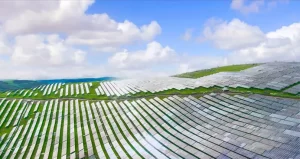As global carbon emissions from the ICT sector surpass those of the aviation industry, the urgency for sustainable technology has shifted from optional to existential. Enter Huawei, a company redefining its role from telecom giant to green tech trailblazer. Beyond mere carbon neutrality pledges, Huawei is engineering an ecosystem where cutting-edge ICT not only minimizes environmental harm but actively regenerates ecosystems. This isn’t just corporate responsibility—it’s a radical reimagining of how technology can coexist with, and even enhance, the natural world.
The Green Network Revolution: Rethinking Infrastructure
Huawei’s GreenSite and GreenLink initiatives are transforming telecom networks—the backbone of digital economies—into models of efficiency:
- Solar-Powered 5G Base Stations: Deployed across sun-drenched regions like Saudi Arabia and Kenya, these stations slash diesel dependency by 90%. A single site in Riyadh generates 12 MWh annually, powering 20 households while supporting 5G connectivity.
- AI-Driven Energy Optimization: Huawei’s PowerStar solution uses machine learning to predict traffic patterns, dynamically adjusting power usage. In Germany, this reduced base station energy waste by 35% during off-peak hours.
- Recyclable Tower Designs: Modular towers made from 85% recycled aluminum cut deployment emissions by 40% and can be disassembled for reuse.

Data Centers: From Energy Hogs to Climate Allies
Traditional data centers consume 200TWh of electricity yearly—equivalent to Iran’s total energy use. Huawei’s CloudGreen architecture flips this script:
- Liquid Cooling Technology: Direct-to-chip cooling cuts energy use by 60% compared to air-cooled systems. A Huawei cloud region in Guizhou, China, achieved a PUE (Power Usage Effectiveness) of 1.15, far below the industry average of 1.55.
- Waste Heat Recycling: Partnering with district heating providers, Huawei channels excess heat from data centers to warm 10,000 homes in Ulanqab, reducing coal consumption by 32,000 tons annually.
- AI-Optimized Workloads: Neural networks schedule non-urgent tasks (e.g., backups) during periods of renewable energy surplus, achieving 80% clean energy utilization in Nordic regions.
Circular Economy: Closing the Loop on E-Waste
With 53 million metric tons of e-waste generated globally in 2023, Huawei’s Full-Lifecycle Sustainability Framework tackles the crisis:
- Modular Smartphones: The Mate 60 Pro allows users to replace batteries, screens, and cameras, extending device lifespans by 3-5 years. Over 1 million units sold have diverted 8,000 tons of e-waste.
- Battery Reincarnation: Retired telecom batteries get second lives in solar storage systems. A pilot in Nigeria repurposed 20,000 batteries, powering 500 off-grid clinics.
- Supplier Green Codes: 95% of Huawei’s suppliers now meet strict sustainability criteria, including zero hazardous chemicals and 70% recycled packaging.
Empowering Industries: ICT as a Sustainability Multiplier
Huawei’s tech isn’t just greening its operations—it’s enabling sectors to decarbonize:
- Smart Agriculture: In partnership with the FAO, Huawei’s FarmAware platform uses IoT sensors and AI to reduce water usage by 50% in Pakistan’s rice fields while boosting yields by 20%.
- Low-Carbon Logistics: For Maersk, Huawei’s 5G+AI Port Solution optimized crane routes in Rotterdam, cutting diesel use by 1.2 million liters yearly.
- Renewable Integration: Huawei’s Digital Power division manages 400GW of solar and wind farms globally, preventing 180 million tons of CO2 emissions—equivalent to planting 4.5 billion trees.
The Human Factor: Building a Green Tech Workforce
Sustainability requires more than hardware—it demands skilled advocates. Huawei’s Seeds for the Future 2.0 program has trained 150,000 engineers in 150 countries on green ICT practices. Key initiatives:
- Eco-Startup Incubators: In Brazil, graduates developed AI to track illegal deforestation, protecting 12,000 hectares of Amazon rainforest.
- Women in Green Tech: Over 40% of participants are women, with many leading solar microgrid projects in rural India and Nigeria.
- Policy Advocacy Labs: Collaborating with the EU and ASEAN, Huawei helps draft regulations on e-waste recycling and energy-efficient 6G standards.
Transparency and Accountability: Walking the Talk
While greenwashing plagues the tech sector, Huawei’s approach is rooted in verifiable metrics:
- Science-Based Targets: Committed to cutting Scope 1-3 emissions by 68% per unit of revenue by 2030, validated by the SBTi.
- Third-Party Audits: Annual reviews by TÜV Rheinland confirm carbon claims, with real-time emissions data accessible via Huawei’s Carbon Guardian platform.
- Open Source Sharing: Patents like its graphene-based cooling film are licensed freely to accelerate industry-wide adoption.

Leave a comment